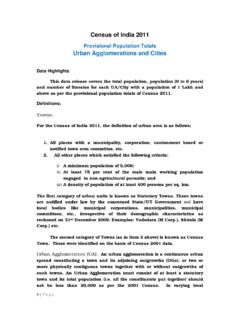Transcription of Table: Occupational Distribution of Work Force by …
1 1 1. Introduction In an earlier paper based on the NSS Report on Key Results from the NSS 55th Round Employment-Unemployment Survey 1999-2000 (NSSO, 2000), we had examined the changes during the 1990s in the size and structure of work Force ; the extent of unemployment and under employment; labour productivity; days worked; and, wage earnings per worker and per head of population in rural and urban India (Sundaram, 2001). Since then the provisional population Totals based on population Census 2001 (RGI, 2001) have been released which indicate that the India's population as on 1st March 2001 was 1027 million rather than the 1012 million in the official population projections for India (RGI, 1996).
2 This necessitates revisions in the estimates of population and of work Force for 1993-94 and 1999-2000 and hence also in the estimates of labour productivity. Besides carrying out the necessary revisions in the size of the work Force (and in labour productivity) based on the results of the 2001 population Census, we offer in this paper a more detailed industrial Distribution of the work Force as well as an occupation Distribution of the work Force based on additional tables now available from the NSS 55th Round Employment-Unemployment Survey (NSSO 2001). A closer analysis of the 55th Round Tabulation and a better understanding of NIC 1998 showed that, in the Key Results report, the work Force in "repair services" (industry group 97 as per NIC 1987) had been shown as part of Industry Division, Trade, Hotels and Restaurants (Division 6 as per NIC 1987).
3 With the availability of separate estimates of work Force in "repair services" for 1999-2000, and, consistent with the current practice in National Accounts (where repair services are merged with Manufacturing), work Force in Manufacturing and Repair Services are combined together and, the estimated number of workers in "Repair Services" is removed from the estimates of work Force in the Trade, Hotels and Restaurants sector for 1999-2000. Corresponding revisions have also been made in the estimates of work Force in Industry Division 9 (Community, Social and Personal Services) for 1993-94.
4 So that, for all the three Industry Divisions, namely, Manufacturing (including repair services), Trade, Hotels and Restaurants, and Community, Social and Personal Services, the work Force estimates for 1993-94 and 1999-2000 are now fully comparable. 2 In order to lend a long-term perspective to the changes in the Industry-occupation structure of the work Force , comparable estimates for 1961 based on the 1961 population Census have been placed alongside the estimates for 1993-94 and 1999-2000. In respect of agricultural wages and earnings, one of the issues highlighted in some recent studies, including the Mid-Term Appraisal of the 9th Five Year Plan, is the alleged slow down in the growth of real wages in rural India during the 1990s relative to the growth during the 1980s.
5 These results are based on the wage-statistics from Agricultural Wages in India. We examine the evidence on average daily wage earnings from the NSS quinquennial Employment-Unemployment Surveys for 1983, 1993-94 and 1999-2000. Since the data from the NSS reflect the daily wages actually received by casual wage labourers for different operations over a very large number of sample person-days (over 268,000 in 1999-2000), the Employment-Unemployment Surveys are expected to provide a better database on this issue. Finally, we examine the evidence from the Employment-Unemployment Survey on the issue of changes in the incidence of poverty on the basis of the size- Distribution of per capita consumption expenditure emerging from the canvassing of an abridged consumer expenditure schedule from the sample households surveyed in the 55th Round Employment-Unemployment Survey.
6 Being canvassed over a different set of households (from that surveyed for the 55th Round Consumer Expenditure Survey) with a 30-day reference period for food, paan, tobacco and intoxicants, as in the 1993-94 Survey, these estimates may be expected to be free from the problem of possible "contamination" from the simultaneous canvassing of expenditure on these items with two reference periods of 7-days and 30-days as in the 55th Round Consumer Expenditure Survey. Admittedly, two sources of non-comparability with the results of the 1993-94 Survey would still remain.
7 The first of these arises from the canvassing, in the 55th Round Employment-Unemployment Survey, of an abridged rather than a detailed consumer expenditure schedule as was done in the 1993-94 Survey. The second source of non-comparability arises from the fact that, in the 55th Round, both in the Consumer Expenditure Survey and in the Employment-Unemployment Survey, the 3 reference period of "last 365 days" was used in respect of expenditure on durables as well as certain items of miscellaneous expenditure such as school fees, medical expenses involving hospitalisation etc.
8 In the 1993-94 Survey, the published size-distributions of per capita consumer expenditure are based on a uniform 30-day reference period for all items of expenditure. Notwithstanding the above, the size-distributions from the Employment-Unemployment Survey provide an important alternative data base to examine the issue of changes in the incidence of poverty in the nineteen nineties. Given that the use of an abridged schedule is likely to result in an understatement rather than an overstatement of the consumption expenditure and since, durables and other items of consumption expenditure subject to the 365 day reference period in the 55th Round, do not figure significantly in the consumption basket of the poor (see Sundaram & Tendulkar, 2001)
9 , a reduction in the incidence of poverty established by reference to the size- Distribution from the 55th Round Employment-Unemployment Survey, especially if it is sizeable, may be taken to be more definitive1. This data base is used to derive estimates of proportion of population below the poverty line, separately, by gender, age and rural- urban location at the all-India level and separately for the rural and the urban populations in 15 major States. This data base is also exploited to examine, at the all-India level, the changes in the proportion of households below the poverty line for rural households differentiated by means of livelihood.
10 2. The Size of the Work Force We begin with our revised estimates of population and work Force as on 1st January 1994 and 1st January 2000 - the mid-points of the Survey Years 1993-94 and 1999-2000. As noted in the introduction, the population estimates are based on an interpolation of the estimates of the population as revealed by the 1991 population Census and the provisional population Totals from the 2001 population Census. (Table 1). In relation to our previous estimates (Sundaram 2001), the revised 1 In his paper to the NSS Golden Jubilee Seminar, Abhijit Sen, (Sen 2001) on the basis of his analysis of the NSS 51st, 52nd, 53rd and 54th Round Surveys, has drawn attention to the possibility that the use of the 365-day reference period for durables etc.










